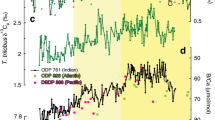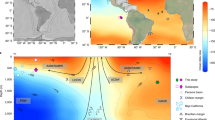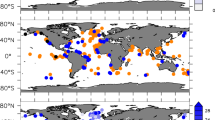Abstract
Oxygen isotope ratios (δ18O) of foraminifera in marine sediment records have fundamentally shaped our understanding of the ice ages and global climate change. Interpretation of these records has, however, been challenging because they reflect contributions from both ocean temperature and ice volume. Here, instead of disentangling, we reconstruct global benthic foraminiferal δ18O across the last deglaciation (18–11.5 ka) with ice volume constraints from fossil corals and ocean temperature constraints from ice core noble gases. We demonstrate that, while ocean temperature and ice volume histories are distinct, their summed contributions to δ18O agree remarkably well with benthic δ18O records. Given the agreement between predicted and observed δ18O, we further build upon recent insight into global energy fluxes and introduce a framework to quantitively reconstruct top-of-atmosphere net radiative imbalance, or Earth’s energy imbalance, from δ18O. Finally, we reconstruct 150,000 years of energy imbalance, which broadly follows Northern Hemisphere summer insolation but shows millennial-scale energy gain during the cold intervals surrounding Heinrich events. This suggests that, in addition to external forcing, internal variability plays an important role in modifying the global energy budget on long (millennial-plus) timescales.
This is a preview of subscription content, access via your institution
Access options
Access Nature and 54 other Nature Portfolio journals
Get Nature+, our best-value online-access subscription
$29.99 / 30 days
cancel any time
Subscribe to this journal
Receive 12 print issues and online access
$259.00 per year
only $21.58 per issue
Buy this article
- Purchase on Springer Link
- Instant access to full article PDF
Prices may be subject to local taxes which are calculated during checkout



Similar content being viewed by others
Data availability
File including the reconstructions from this study and original data used to produce reconstructions is available at https://doi.org/10.5281/zenodo.8237374.
References
Zachos, J., Pagani, H., Sloan, L., Thomas, E. & Billups, K. Trends, rhythms, and aberrations in global climate 65 Ma to present. Science 292, 686–693 (2001).
Friedrich, O., Norris, R. D. & Erbacher, J. Evolution of middle to late Cretaceous oceans—a 55 m.y. record of Earth’s temperature and carbon cycle. Geology 40, 107–110 (2012).
Emiliani, C. Pleistocene temperatures. J. Geol. 63, 538–578 (1955).
Shackleton, N. Oxygen isotope analyses and pleistocene temperatures re-assessed. Nature 215, 15–17 (1967).
McDuff, R. E. The chemistry of interstitial waters from the upper ocean crust, site 395, Deep Sea Drilling Project Leg 78B. In Initial Reports of the Deep Sea Drilling Project 86 (eds Heath, G. R. et al.) 675–687 (U.S. Government Printing Office, 1984).
Schrag, D. P. et al. The oxygen isotopic composition of seawater during the Last Glacial Maximum. Quat. Sci. Rev. 21, 331–342 (2002).
Shackleton, N. J. The 100,000-year ice-age cycle identified and found to lag temperature, carbon dioxide, and orbital eccentricity. Science 289, 1897–1902 (2000).
Waelbroeck, C. et al. Sea-level and deep water temperature changes derived from benthic foraminifera isotopic records. Quat. Sci. Rev. 21, 295–305 (2002).
Cutler, K. B. et al. Rapid sea-level fall and deep-ocean temperature change since the last interglacial period. Earth Planet. Sci. Lett. 206, 253–271 (2003).
Bintanja, R., Van De Wal, R. S. W. & Oerlemans, J. Modelled atmospheric temperatures and global sea levels over the past million years. Nature 437, 125–128 (2005).
Elderfield, H. et al. Evolution of ocean temperature and ice volume through the mid-Pleistocene climate transition. Science 337, 704–709 (2012).
Shakun, J. D., Lea, D. W., Lisiecki, L. E. & Raymo, M. E. An 800-kyr record of global surface ocean δ18O and implications for ice volume–temperature coupling. Earth Planet. Sci. Lett. 426, 58–68 (2015).
Rohling, E. J. et al. Sea level and deep-sea temperature reconstructions suggest quasi-stable states and critical transitions over the past 40 million years. Sci. Adv. 7, 5326–5351 (2021).
von Schuckmann, K. et al. Heat stored in the Earth system: where does the energy go? Earth Syst. Sci. Data 12, 2013–2041 (2020).
Hansen, J. et al. Climate change: Earth’s energy imbalance: confirmation and implications. Science 308, 1431–1435 (2005).
Baggenstos, D. et al. Earth’s radiative imbalance from the Last Glacial Maximum to the present. Proc. Natl Acad. Sci. USA 116, 14881–14886 (2019).
Lambeck, K., Rouby, H., Purcell, A., Sun, Y. & Sambridge, M. Sea level and global ice volumes from the Last Glacial Maximum to the Holocene. Proc. Natl Acad. Sci. USA 111, 15296–15303 (2014).
Bereiter, B., Shackleton, S., Baggenstos, D., Kawamura, K. & Severinghaus, J. Mean global ocean temperatures during the last glacial transition. Nature 553, 39–44 (2018).
Headly, M. A. & Severinghaus, J. P. A method to measure Kr/N2 ratios in air bubbles trapped in ice cores and its application in reconstructing past mean ocean temperature. J. Geophys. Res. 112, D19105 (2007).
Shackleton, S. et al. Is the noble gas-based rate of ocean warming during the Younger Dryas overestimated? Geophys. Res. Lett. 46, 5928–5936 (2019).
Lisiecki, L. E. & Stern, J. V. Regional and global benthic δ18O stacks for the last glacial cycle. Paleoceanography 31, 1368–1394 (2016).
Oerlemans, J. Glacial cycles and ice-sheet modelling. Clim. Change 4, 353–374 (1982).
Osman, M. B. et al. Globally resolved surface temperatures since the Last Glacial Maximum. Nature 599, 239–244 (2021).
Hamme, R. C. & Severinghaus, J. P. Trace gas disequilibria during deep-water formation. Deep Sea Res. Part I Oceanogr. Res. Pap. 54, 939–950 (2007).
Pöppelmeier, F. et al. The effect of past saturation changes on noble gas reconstructions of mean ocean temperature. Geophys. Res. Lett. 50, e2022GL102055 (2023).
Austermann, J., Mitrovica, J. X., Latychev, K. & Milne, G. A. Barbados-based estimate of ice volume at Last Glacial Maximum affected by subducted plate. Nat. Geosci. 6, 553–557 (2013).
Simms, A. R., Lisiecki, L., Gebbie, G., Whitehouse, P. L. & Clark, J. F. Balancing the last glacial maximum (LGM) sea-level budget. Quat. Sci. Rev. 205, 143–153 (2019).
Yokoyama, Y., Lambeck, K., De Deckker, P., Johnston, P. & Fifield, L. K. Timing of the Last Glacial Maximum from observed sea-level minima. Nature 406, 713–716 (2000).
Yokoyama, Y. et al. Rapid glaciation and a two-step sea level plunge into the Last Glacial Maximum. Nature 559, 603–607 (2018).
Poirier, R. K. et al. Quantifying diagenesis, contributing factors, and resulting isotopic bias in benthic foraminifera using the foraminiferal preservation index: implications for geochemical proxy records. Paleoceanogr. Paleoclimatol. 36, e2020PA004110 (2021).
Hemming, S. R. Heinrich events: massive late Pleistocene detritus layers of the North Atlantic and their global climate imprint. Rev. Geophys. 42, RG1005 (2004).
Bohm, E. et al. Strong and deep Atlantic meridional overturning circulation during the last glacial cycle. Nature https://doi.org/10.1038/nature14059 (2015).
Vidal, L. et al. Evidence for changes in the North Atlantic Deep Water linked to meltwater surges during the Heinrich events. Earth Planet. Sci. Lett. 146, 13–27 (1997).
Galbraith, E. D., Merlis, T. M. & Palter, J. B. Destabilization of glacial climate by the radiative impact of Atlantic Meridional Overturning Circulation disruptions. Geophys. Res. Lett. 43, 8214–8221 (2016).
Grant, K. M. et al. Rapid coupling between ice volume and polar temperature over the past 150,000 years. Nature 491, 744–747 (2012).
Dalton, A. S. et al. The marine δ18O record overestimates continental ice volume during Marine Isotope Stage 3. Glob. Planet. Change 212, 103814 (2022).
de Gelder, G. et al. High interstadial sea levels over the past 420ka from the Huon Peninsula, Papua New Guinea. Commun. Earth Environ. 3, 256 (2022).
Pico, T. Toward new and independent constraints on global mean sea‐level highstands during the Last Glaciation (Marine Isotope Stage 3, 5a, and 5c). Paleoceanogr. Paleoclimatol. 37, e2022PA004560 (2022).
Yokoyama, Y., Esat, T. M. & Lambeck, K. Coupled climate and sea-level changes deduced from Huon Peninsula coral terraces of the last ice age. Earth Planet. Sci. Lett. 193, 579–587 (2001).
Shackleton, S. et al. Global ocean heat content in the Last Interglacial. Nat. Geosci. 13, 77–81 (2020).
Dutton, A., Webster, J. M., Zwartz, D., Lambeck, K. & Wohlfarth, B. Tropical tales of polar ice: evidence of Last Interglacial polar ice sheet retreat recorded by fossil reefs of the granitic Seychelles islands. Quat. Sci. Rev. 107, 182–196 (2015).
O’Leary, M. J. et al. Ice sheet collapse following a prolonged period of stable sea level during the last interglacial. Nat. Geosci. 6, 796–800 (2013).
Dyer, B. et al. Sea-level trends across The Bahamas constrain peak last interglacial ice melt. Proc. Natl Acad. Sci. USA 118, e2026839118 (2021).
Wolff, E. W., Fischer, H., van Ommen, T. & Hodell, D. A. Stratigraphic templates for ice core records of the past 1.5 Myr. Clim 18, 1563–1577 (2022).
Clark, P. U. & Pollard, D. Origin of the Middle Pleistocene Transition by ice sheet erosion of regolith. Paleoceanography 13, 1–9 (1998).
Rhodes, R. H. et al. Enhanced tropical methane production in response to iceberg discharge in the North Atlantic. Science 348, 1016–1019 (2015).
Broecker, W. S. Massive iceberg discharges as triggers for global climate change. Nature 372, 421–424 (1994).
Cheng, H. et al. The Asian monsoon over the past 640,000 years and ice age terminations. Nature 534, 640–646 (2016).
Berger, A. & Loutre, M. F. Insolation values for the climate of the last 10 million years. Quat. Sci. Rev. 10, 297–317 (1991).
Bereiter, B., Kawamura, K. & Severinghaus, J. P. New methods for measuring atmospheric heavy noble gas isotope and elemental ratios in ice core samples. Rapid Commun. Mass Spectrom. 32, 801–814 (2018).
Haeberli, M. et al. Snapshots of mean ocean temperature over the last 700 000 years using noble gases in the EPICA Dome C ice core. Clim. Past 17, 843–867 (2021).
Jenkins, W. J., Lott, D. E. & Cahill, K. L. A determination of atmospheric helium, neon, argon, krypton, and xenon solubility concentrations in water and seawater. Mar. Chem. 211, 94–107 (2019).
Shackleton, N. J. Attainment of isotopic equilibrium between ocean water and the benthonic foraminifera genus Uvigerina: isotopic changes in the ocean during the last glacial. Colloq. Int. Cent. Natl Rech. Sci. 219, 203–210 (1974).
Sarmiento, J. L. & Gruber, N. Ocean Biogeochemical Dynamics (Princeton Univ. Press, 2006).
Charette, M. & Smith, W. The volume of Earth’s ocean. Oceanography 23, 112–114 (2010).
Acknowledgements
We thank M. Bender, J. Higgins and J. Severinghaus for helpful discussions and encouragement in pursuing this project. We are grateful to J. Severinghaus for pointing us to the Great Barrier Reef sea level reconstruction. Thanks to S. Hines for her expertise and advice on the interpretation of marine sediment records. The first author was supported by National Science Foundation awards 1744993 and 2052958. A.S. was supported by National Science Foundation award 2049359.
Author information
Authors and Affiliations
Contributions
S.S. and D.B. designed the research. A.S. and S.S. established the method for splined reconstructions via Monte Carlo error propagation. D.B. and S.S. re-analysed the published noble gas records to produce the splined ocean temperature reconstruction. S.S., A.S., D.B. and L.E.L. analysed the data. S.S. wrote the paper with input from all authors.
Corresponding author
Ethics declarations
Competing interests
The authors declare no competing interests.
Peer review
Peer review information
Nature Geoscience thanks the anonymous reviewers for their contribution to the peer review of this work. Primary Handling Editor: James Super, in collaboration with the Nature Geoscience team.
Additional information
Publisher’s note Springer Nature remains neutral with regard to jurisdictional claims in published maps and institutional affiliations.
Extended data
Extended Data Fig. 1 Global mean ocean temperature (MOT) evolution over the last 25 ka.
Individual samples from WAIS Divide18 (WDC, blue), EPICA Dome C16 (EDC, red) and Taylor Glacier20,40 (TG, yellow) are shown as points with 1σ error bars calculated from published analytical uncertainties and uncertainties associated with box model inputs (see Methods). Splined reconstruction from these combined data (MOTcomb) are shown in green with 1σ confidence envelope shown in shading centered on mean spline (solid line). Note that absolute mean ocean temperature (rather than temperature anomaly) is shown here.
Extended Data Fig. 2 Raw relative sea level data and calculated eustatic sea level curves considered in this study.
In a) points represent the individual raw observations from refs. 17 (yellow) and29 (orange) and solid lines show the splines of the eustatic sea level curves from each study that are used to compute the ice volume component of δ18Obenth. b) shows the number of raw sea level observations for each study per thousand-year bin.
Extended Data Fig. 3
Agnostic reconstruction of Earth’s energy imbalance (EEI) from δ18Obenth. Here we outline the steps taken to calculate EEI from δ18Obenth (left to right), which are described in detail in the methods. Briefly, δ18Obenth21 (left) is converted into sea level (second panel, top in yellow) and ocean temperature (second panel, bottom in green) using the assumption that the δ18Obenth signal is entirely attributed to one or the other. We then calculate the energy change associated with ice sheet buildup/melting from the sea level reconstruction (third panel, yellow) and with ocean warming/cooling from the ocean temperature reconstruction (third panel, green). EEI is then calculated by taking the time derivative of the energy changes and averaging over Earth’s surface area (panel 4). The gray lines in panels 3 and 4 show the calculated the global energy change (ΔEglobal) and EEI if we assume a constant 60/40 split of δ18Obenth between ice volume and ocean temperature changes.
Extended Data Fig. 4
Sensitivity of calculated (a) global energy change (ΔEglobal) and (b) Earth’s energy imbalance (EEI) to applied δ18Oice. Here we assume the δ18Obenth21 record is entirely an ice volume signal and calculate the energy change using a wide range of mean ice sheet δ18O (−35‰ to −25‰) to test the sensitivity of calculated EEI to this parameter.
Rights and permissions
Springer Nature or its licensor (e.g. a society or other partner) holds exclusive rights to this article under a publishing agreement with the author(s) or other rightsholder(s); author self-archiving of the accepted manuscript version of this article is solely governed by the terms of such publishing agreement and applicable law.
About this article
Cite this article
Shackleton, S., Seltzer, A., Baggenstos, D. et al. Benthic δ18O records Earth’s energy imbalance. Nat. Geosci. 16, 797–802 (2023). https://doi.org/10.1038/s41561-023-01250-y
Received:
Accepted:
Published:
Issue Date:
DOI: https://doi.org/10.1038/s41561-023-01250-y



